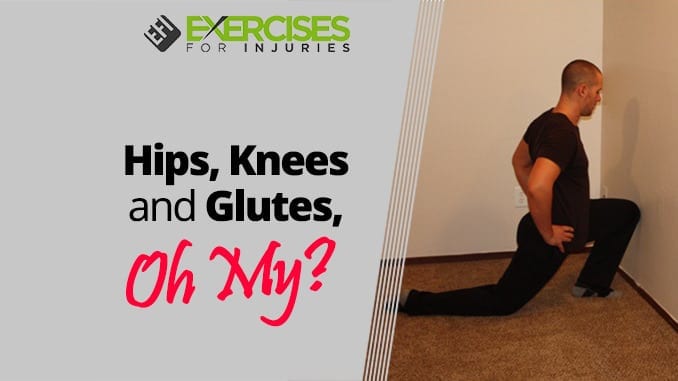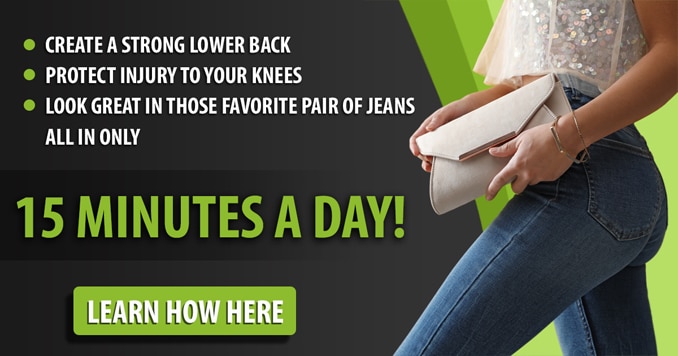
The hips, knees, and glutes are some of the human body’s most significant, most robust, and most dynamic muscles.
I am no stranger to knee pain. I’ve had multiple knee injuries and have spent 1,000’s hours and 10’s thousands of dollars trying to figure out the best ways to make my knees feel better.
In this article, I want to show you my path from bruised and broken to strong. You can expect awesome results. You can use this Method with your clients or yourself, and if you do.
I’ve said it before, and I’ll repeat it. Many people walk into my gym with that familiar waddle that tells me they have no idea how to move with their lower body. Hips are the key to developing a strong lower body.
I ask them to squat, and they display the all too common knee collapse, usually coupled with an anterior dominance. Now, I am not a therapist. But I do, however, know how a biomechanically correct squat should look, and more than 99% of the people I see squat for the first time do it wrong.
Common Problem – The Quads Dominate
Let’s look at one of the fundamental issues people have when squatting.
An anterior or quad dominance is widespread among gym-goers and is one of the main culprits of unproductive lower body training, muscle imbalances, and injury.
How do you know when someone is quad dominant?
Here’s how.
When someone squats primarily on their toes, it is a sign that they are not moving correctly. If you are a trainer, your client likely thinks only of the muscles they can see in the mirror (the show muscles) and not the more powerful stable forces on the backside of their body (the go muscles).
This type of squat asks the knee joint to do what the hip joint should and puts way too much unnecessary stress on the knee joint. You must first solve this problem to have a productive lower body routine.
Here are the three most common ways to fix quad dominance problems in yourselves and others.
Fix #1 – Demand 70% of your weight stays on the heels.
By simply being aware of your heels being in contact with the ground and applying a number such as 70% of the weight, you will immediately begin to move more through the hip and less through your knee joint.
If you or your client isn’t getting this, lie down on the ground and pull up on your client’s heels, demanding that they squat without letting you lift them off the ground. This proprioceptive training will bypass their conscious movement and make it easier for them to move better subconsciously.
Fix #2 – Get more mobile ankles.
People’s ankles these days are tighter than ever. Not being able to move through your ankles is another common reason people roll up on their toes when squatting. To loosen up your ankle joint, try the following exercise.
Come to a kneeling position with your front toes only a few inches away from a wall. Keeping your heel in contact with the ground, move your knee towards the wall and back several times. To make the stretch more authoritarian, move your toes further from the wall and if you find your heel coming off the ground, move your toes closer toward the wall. Your goal should be to be able to touch your knee to the wall keeping your heel flat while your toes are roughly 4″ from the wall.
Fix #3 – Bury your shins in the sand.
Finally, one of the best cues I use to help people learn how to move through their hips is to imagine their shins buried in the sand as they squat. Try descending into the bottom position of the squat, keeping 70% of the weight on your heels while not letting your shins move at all.
One of my favorite drills that helps drive this point home is to hold a dowel in front of a client’s shins as they squat and tell them, “don’t let your shins hit my stick.” This is a powerful cue that will change the way they move quickly.
Once you solve these three issues, you will be more efficiently moving through your hips and putting less stress on your knees. This will allow you to safely perform more complex bodyweight and weighted lower body exercises and achieve your entire lower body potential.
So, The choice is yours.
Move through your knees, develop muscle imbalances, shortchange your strength and power, and likely get injured. Or, move through your hips and get more robust than you ever thought possible, eliminate knee pain, and finally achieve your lower body potential.
Choose Wisely!
For more detailed instructions, including common mistakes and fixes on dozens of different lower bodies, Check out Tyler’s new lower body training program.
It includes three different detailed manuals, which show you how to build a strong foundation of flexibility and stability for your lower body and teach you how to safely learn complex bodyweight and weighted lower body exercises using his new PM3 Method.
Plus, until Midnight Friday, December 14th, you can get it for way less than it’s worth at only $7!!
Tyler Bramlett




